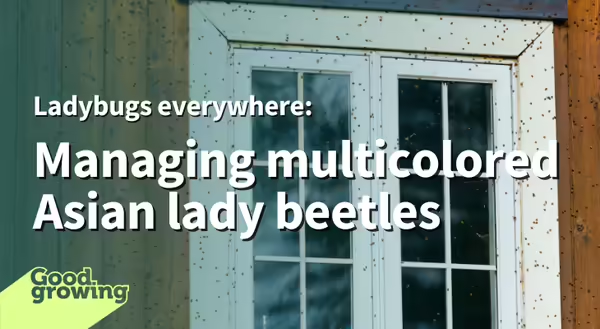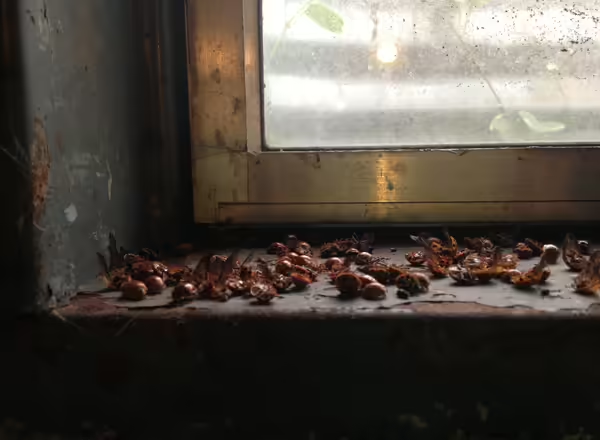
As the days get shorter and the temperatures get cooler, many species of insects will search for places to spend the winter. Depending on the insect, they may seek out a variety of locations, such as in soil, under leaf litter, under tree bark, or even in our homes. One that we commonly encounter trying to enter homes is the multicolored Asian lady beetle (Harmonia axyridis).
Identifying multicolored Asian lady beetles
Multicolored Asian lady beetles are generally larger than native lady beetle species, about ¼ inch long. As their name implies, the beetles can vary in color, which can range from yellowish-orange to red or even black. The beetles can have anywhere from zero to 19 spots. One characteristic often used to identify them is the presence of an M-shaped pattern on the pronotum. However, this pattern isn’t always present.


How did multicolored Asian lady beetles get to the United States?
The multicolored Asian lady beetle is native to Asia. They were first introduced in 1916 in California in hopes of using it as a biological control agent for aphids in pecans. Despite numerous releases across the U.S. during the 1960s-80s, multicolored Asian lady beetles did not become established until 1988 in Louisiana. There is some debate as to where that population came from, whether from an intentional release or an accidental introduction. Regardless of how they got there, multicolored Asian lady beetles rapidly spread across the U.S. and Canada.
The good and bad of multicolored Asian lady beetles
Multicolored Asian lady beetles feed on aphids and other small soft-bodied insects and mites, and they can be quite voracious. Larval beetles can feed on up to 370 aphids during their development, and adults can consume up to 65 aphids per day.
Unfortunately, multicolored Asian lady beetles can also be problematic in our landscapes. They can outcompete native lady beetles and other predatory insects for food. Multicolored Asian lady beetles will also feed on native lady beetles and predators (eggs and larvae). In many places, the arrival of multicolored Asian lady beetles has corresponded with a decline in native lady beetle populations.


Why do multicolored Asian lady beetles get in houses?
Multicolored Asian lady beetles can be a nuisance as aggregate on and make their way into homes and other buildings in search of somewhere to overwinter. They will begin to look for places to overwinter during warm days (around 64°F) after a significant drop in temperatures (usually near-freezing temperatures).
In many places in their native range, multicolored Asian lady beetles will overwinter in cracks and crevices in rockfaces or cliffs. Since we lack these in most parts of Illinois, the next best thing is your house (or other buildings). They are attracted to prominent isolated objects with high color contrasts which in many areas are homes or other buildings.
Once they find an attractive location, they will usually form aggregations on walls with a western or southern exposure (these are typically warmer) and will then begin to look for cracks and crevices to overwinter in, such as underneath siding, soffits, door or window frames, attics, soffits, and wall voids. Some beetles may make their way indoors.
Those beetles that make it indoors will eventually die because of lack of food, and they will quickly burn through their fat reserves because of warm indoor temperatures (those that remain cool will slowly use their fat reserves and will last throughout the winter). While indoors, they do not reproduce, nor do they feed on wood or other household objects. However, some people may also be allergic to them and that can result in itchy eyes and nose, asthma, and welts.
Do multicolored Asian lady beetles bite?
While all lady beetles are capable of biting, multicolored Asian lady beetles have a reputation for biting people. This is likely in part because we encounter them in large numbers and their more aggressive behavior. They may bite if they are trapped beneath clothing or when handled Fortunately, they can’t break skin and only cause minor discomfort.
How do I get rid of multicolored Asian lady beetles in my house?
As the saying goes, an ounce of prevention is worth a pound of cure. The best management strategy is to keep them out of your home in the first place (exclusion).
- Make sure windows and doors fit tight
- Make sure window screens don’t have any holes in them
- Seal any openings, cracks, and crevices around the foundation, pipes, wires, and chimney
- Make sure siding, eaves, and soffits are in good condition
Once they get indoors, they can be swept up and released outdoors or placed in soapy water and disposed of. One drawback to sweeping is that when disturbed, lady beetles will release a yellow defensive chemical from their legs, known as reflex bleeding, which smells bad and can stain.
To avoid staining, lady beetles can be vacuumed, bags should be emptied to prevent beetles from escaping. If you don’t want to have to repeatedly empty your vacuum or smell them every time you vacuum, you can stick a pantyhose inside of the hose attachment and secure it to the end with a rubber band. The beetles will be collected into the pantyhose, which can then be removed and disposed of.
Insecticides can be applied to building exteriors (make sure to read and follow all label directions), but timing is important. Insecticides should be applied before lady beetles begin to search for somewhere to overwinter. It is important to note that insecticides applied to the perimeter of buildings are often ineffective because the lady beetles are rather mobile, and it can be challenging to get adequate control of them. Insecticides should not be applied to entire landscapes to manage multicolored Asian lady beetles.
Pesticides are generally not recommended to manage multicolored Asian lady beetles indoors because they are typically overwintering in inaccessible areas (wall voids, etc.), and they also unnecessarily expose people to pesticides.
Good Growing Fact of the Week: Multicolored Asian lady beetles have also been found to feed on fruits, such as apples, peaches, plums, pears, pumpkins, raspberries, and grapes. They can be particularly problematic in grapes grown for wine production. If the beetles are in grape clusters when they are harvested and processed, they can give an off-flavor to wine known as ladybug taint.
Resources and for more information:
Botezatu, A, and G Pickering. 2010. Review of Ladybug (Coccinellidae) Taint in Wine. In Managing Wine Quality, edited by Andrew Reynolds. Philadelphia, PA: Woodhead Publishing. https://doi.org/10.1533/9781845699987.2.418.
Koch, Robert L., Robert C. Venette, and William D. Hutchison. 2006. “Invasions by Harmonia axyridis (Pallas) (Coleoptera: Coccinellidae) in the Western Hemisphere: Implications for South America.” Neotropical Entomology 35 (4): 421–34. https://doi.org/10.1590/s1519-566x2006000400001.
Koch, Robert L., and Tederson L. Galvan. 2007. “Bad Side of a Good Beetle: The North American Experience with Harmonia axyridis.” BioControl 53 (1): 23–35. https://doi.org/10.1007/s10526-007-9121-1.
Nalepa, C A, G G Kennedy, and C Brownie. 2005. “Role of Visual Contrast in the Alighting Behavior ofHarmonia axyridis (Coleoptera: Coccinellidae) at Overwintering Sites.” Environmental Entomology 34 (2): 425–31. https://doi.org/10.1603/0046-225x-34.2.425.
Perry, Kayla I, Christie A Bahlai, Timothy J Assal, Christopher B Riley, Katherine J Turo, Leo Taylor, James Radl, flor, Frances S Sivakoff, and Mary M Gardiner. 2024. “Landscape Change and Alien Invasions Drive Shifts in Native Lady Beetle Communities over a Century.” Ecological Applications, August. https://doi.org/10.1002/eap.3024.
Riddick, Eric W. 2016. “Spotlight on the Positive Effects of the Ladybird Harmonia axyridis on Agriculture.” BioControl 62 (3): 319–30. https://doi.org/10.1007/s10526-016-9758-8.
Roy, Helen E., Peter M. J. Brown, Tim Adriaens, Nick Berkvens, Isabel Borges, Susana Clusella-Trullas, Richard F. Comont, et al. 2016. “The Harlequin Ladybird, Harmonia axyridis: Global Perspectives on Invasion History and Ecology.” Biological Invasions 18 (4): 997–1044. https://doi.org/10.1007/s10530-016-1077-6.
Photos:
Multicolored Asian lady beetles - © entomart, https://commons.wikimedia.org
Multicolored Asian lady beetle - regalis, Public Domain, iNaturalist
Lady beetle aggregation - Jared Birk, CC BY-SA 3.0, https://commons.wikimedia.org
Dead multicolored Asian lady beetles - Andrew Holsinger, University of Illinois Extension
Want to get notified when new Good Growing posts are available? SIGN ME UP!
Give us feedback! How helpful was this information (click one): Very helpful | Somewhat helpful | Not very helpful
MEET THE AUTHOR
Ken Johnson is a Horticulture Educator with University of Illinois Extension, serving Calhoun, Cass, Greene, Morgan, and Scott counties since 2013. Ken provides horticulture programming with an emphasis on fruit and vegetable production, pest management, and beneficial insects. Through his programming, he aims to increase backyard food production and foster a greater appreciation of insects